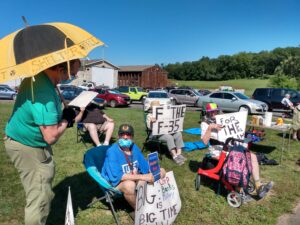“With its strip malls, auto repair shops and used car lots, the stretch of East Washington Avenue between Aberg Avenue and Stoughton Road shows no signs of the revitalization happening a couple of miles to the west, near Downtown.
That could soon change with the addition of a planned bus rapid transit system.
Bill Connors, who heads a coalition of real estate developers, envisions three- and four-story buildings with ground-floor retail stores below apartments, much like those that have sprung up on the Isthmus.
City plans call for high-density housing that would both provide equitable access regardless of income and support a new bus rapid transit (BRT) system that’s expected to begin shuttling commuters between the city’s East and West sides in 2024.
But with the Air National Guard expected to begin flying a fleet of new F-35 fighter jets from nearby Truax Field in 2023, this ¾-mile strip is expected to be subject to noise levels considered too loud for residential development without significant soundproofing.
The conflict has created a dilemma for leaders of a fast-growing city in desperate need of more housing: By allowing the type of high-density development that would support rapid transit, Madison could also subject thousands more people to unhealthy levels of noise.
Connors argues the market will solve the problem, as builders who don’t do enough to muffle the sound will struggle to keep their buildings full.
City Council president Syed Abbas has appointed a council workgroup to explore possible alternatives, including a development moratorium or zoning changes, in an effort to prevent a situation where poor and minority people bear a disproportionate share of the environmental impacts.
“I have to see the situation with the lens of environmental justice,” Abbas said. “If you go historically, the market decided to put all the people of color there — Black and brown folks.”
Military decision
The Air Force last year selected the Wisconsin Air National Guard’s 115th Fighter Wing as one of the first Guard units to fly the military’s new F-35 fighter jets.
There is disagreement on just how much louder the F-35s will be compared to the F-16s that currently fly out of Truax. But there would be more takeoffs and landings, at least initially, which would increase the overall noise exposure for those living near the airport.
In its environmental study, the Air Force estimated at least 1,019 homes would be subject to average daily noise levels above 65 decibels, a level deemed “incompatible” with residential use. Poor and minority residents would be disproportionately affected.
Noise models created for the study show that the 65-decibel zone would extend south into the Carpenter-Ridgeway, Darbo-Worthington and Hawthorne neighborhoods, enveloping a section of East Washington considered ripe for redevelopment.
Areas to the west of the airport would also be subject to more noise, including several parcels being eyed for development such as the 63.6-acre Raemisch Farm, where the council earlier this year nixed a development proposal over noise concerns.
Within the new noise zones, the city’s planning staff has identified a total of 10 sites considered ripe for development that could support up to 1,600 housing units, including as many as 1,200 on BRT routes.

Potential noted
That’s not to say that there are proposals on the table or that the sites are even for sale, though many along East Washington are identified in the neighborhood plan as targets for redevelopment. Yet most have changed little since that plan was adopted 20 years ago.
“The East Washington corridor is important,” said Heather Stouder, the city’s director of planning. “It’s an important piece of the puzzle in regards to accommodating a large amount of growth … in a way that’s fiscally and environmentally responsible and puts more people in easy reach of sustainable transportation options.”
Connors, executive director of Smart Growth Greater Madison, envisions the same type of construction boom that has revitalized parts of East Washington on the Isthmus.
“It just keeps spreading north and east,” Connors said. “The next area that’s probably going to go would be out by the airport.”
As an example, Connors points to the Ella Apartments, a $30 million development under construction just a couple of blocks to the west at 2902 E. Washington Ave.
“At a minimum I would see a bunch of buildings like that in this stretch. Some possibly larger, like the ones closer to the (Capitol) Square,” Connors said. “There’s a lot of very underutilized properties there.”
Buyer beware?
Touyeng Xiong lives in the Truax Apartments, a public housing complex a couple of blocks north of East Washington. Even outside the 65-decibel zone, Xiong said the noise can be “unbearable” when F-16s take off, shaking the building and making it impossible to talk or concentrate.
“You cannot do anything until the sound goes away,” Xiong said. “It’s not just one. It’s one taking off followed by another, for a good minute or two. It’s extremely uncomfortable.”
As long as developers build market-rate housing, Connors said no one would be forced to live there.
“Why don’t you just let renters and developers figure this out?” he said. “Renters are free to go. Maybe not to a place with similar amenities and conveniences, but that’s how the world works: You’re always making these tradeoffs.”
But Xiong questions why anyone would choose to live near the airport and is dubious of claims that people who don’t like the noise would be able to move away given the current cost of housing in Madison.
“It’s not that easy,” Xiong said.
For Abbas, whose district includes the neighborhoods just west and south of the airport, the noise exposure is a matter of public health policy, which he says should be set by elected leaders and not the market.
Research has shown prolonged exposure to noise disrupts sleep and can contribute to high blood pressure, heart disease and impair cognitive development. And while buildings can be insulated to dampen noise, there’s no way to mitigate sound outdoors.
Leaders of the council workgroup did not respond to interview requests, but at a recent meeting Ald. Tag Evers said markets aren’t always transparent.
“You could say, ‘Buyer beware,’ but if these things aren’t disclosed to someone looking for housing and they end up in an untenable situation and unable to break their lease, that’s an injustice,” Evers said. “That’s what we’re trying to address.”

Wait and see
Abbas said he hopes the workgroup can bring a proposal to the council by the end of the year.
Meanwhile, Connors said the discussion, along with the council’s vote to deny development of the Raemisch Farm, has scared developers off any sites with potential noise impacts, creating a de facto moratorium.
In order to accommodate population growth and reach a “healthy” vacancy rate of 5%, Madison needs to add about 2,000 housing units per year on top of an immediate 3,000, according to city staff.
“The city struggles every year to get to that 2,000 figure,” Connors said. “If you take an area that’s prime for redevelopment and say we’re taking that off the menu of what’s possible, it makes it even harder to hit that figure.”
Abbas said there are other East Side sites — including the former Oscar Mayer plant and the Voit Farm on Milwaukee Street — that could be used for residential development.
He suggested using the East Washington corridor for commercial and office buildings, which would help boost BRT ridership without subjecting people to unhealthy noise in their homes.
Abbas notes that the noise contours are simply projections based on modeled flight patterns and may not represent the actual noise levels when the jets are in service.
“My house is one block away from 65 decibels. Sometimes the planes are not too loud. Sometimes they’re extremely loud,” he said. “If the planes are not coming or the scientific data shows the impact is not that bad … we could build housing in the future.”






